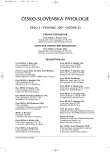The Autopsy of Reinhard Heydrich
Pitva Reinharda Heydricha
Protokol z pitvy Reinharda Heydricha, zemřelého 4. června 1942, osm dnů po atentátu, byl v České republice poprvé zveřejněn až v roce 2004. Z pohledu patologa jeví pitva resp. její protokol řadu neobvyklostí:
– K pitvě došlo poměrně záhy, již asi 4 hodiny po smrti.
– Pitva nebyla provedena na pracovišti patologie, ale v pracovně ředitele nemocnice.
– Šlo o částečnou pitvu – nebyly pitvány hlava a krční orgány.
– V protokolu chybí zevní popis; popsány jsou jen operační rány.
– Není udána hmotnost orgánů.
– A hlavně:
Pitva nezjistila příčinu smrti.
Authors:
I. Šteiner
Authors‘ workplace:
Hradec Králové
; Fingerlandův ústav patologie Lékařské fakulty UK a Fakultní nemocnice
Published in:
Čes.-slov. Patol., 43, 2007, No. 3, p. 114-116
Category:
History of pathology
Overview
Reinhard Heydrich died on 4 June, 1942, eight days after assassination attempted on him in Prague by two members of the Czechoslovak army in Great Britain. The text of his autopsy report became available only in 2004. From the pathologist’s view, the autopsy and the report show several unusual features:
– The autopsy was performed early, only some 4 hours after death.
– It was performed not in an autopsy room, but in the hospital director’s office.
– There was only a partial autopsy; the head and the neck organs were not examined.
– The report lacks description of external examination; only the operation wounds are described.
– The weights of the organs are not given.
– And particularly:
The autopsy did not reveal the cause of death.
Labels
Anatomical pathology Forensic medical examiner ToxicologyArticle was published in
Czecho-Slovak Pathology

2007 Issue 3
Most read in this issue
- The Autopsy of Reinhard Heydrich
- Expression of E-cadherin and c-erbB-2/HER-2/neu Oncoprotein in High-Grade Breast Cancer
- Pleomorphic Epithelioid/Clear Cell Malignant Tumor of the Uterus Exhibiting both Myoid and Melanocytic Differentiation – Leiomyosarcoma or PEComa? A Case Report and a Review of the Literature
- Bloch-Sulzberg Syndrome in Pathology
